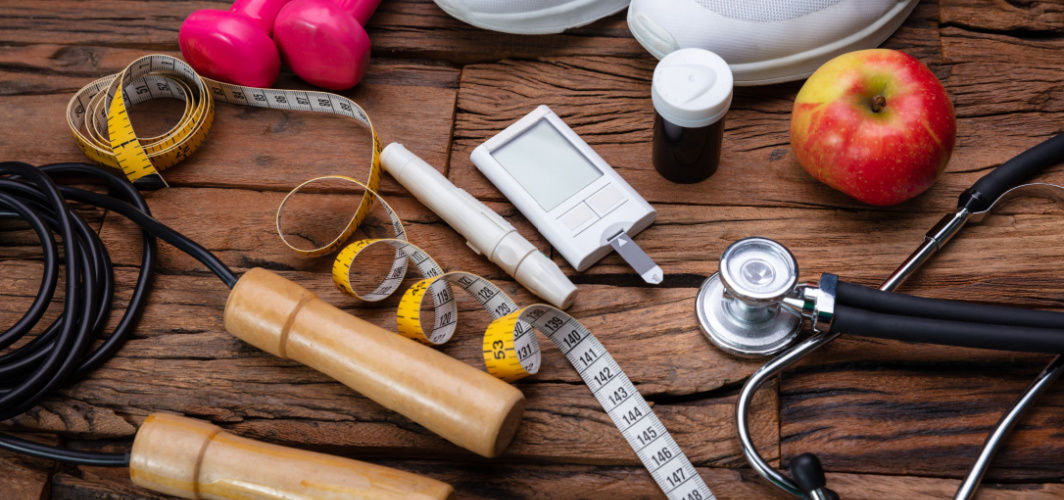Diabetes Management
Diabetes and Skin problems: Keep Them at Bay
5 min read
By Apollo 24/7, Published on - 04 December 2020, Updated on - 29 August 2024
Share this article
0
0 like

What skin problems can be experienced by people with diabetes?
Darkening of skin: Medically called acanthosis nigricans, darkening and thickening of the skin of the neck, armpits, and groin area is a problem commonly seen in diabetics. The skin may also appear raised and dark tan in colour.
Painless patches on the skin: Diabetes can affect the blood supply to the skin resulting in skin condition such as diabetic dermopathy, which appears as painless scaly light brown-red coloured patches usually seen on the front of the legs.
Stiffening of digits: People with diabetes may experience thickening of the skin on their digits, that is the toes, fingers, and hands, which is medically called digital sclerosis. This condition can make the fingers stiff, thick, waxy and difficult to move. It can also be seen on the forearms, upper arms, upper back, shoulders, and neck.
Stiffening of neck and back: This condition looks similar to digital sclerosis as the person experiences thickening of the skin. However, the thickening is seen mostly on the back of the neck and upper back and is mostly seen in overweight people with diabetes.
Red-brown bumps on the skin: This condition is medically called Necrobiosis Lipoidica Diabeticorum, which occurs due to changes in the blood vessels and appears as reddish-brown coloured bumps that turn patchy. The patches can be shiny (wax-like shine) painful and itchy.
Rashes: People with diabetes may witness ring or arc-shaped rashes on the fingers, hands, and feet, which is medically called disseminated granuloma annulare. These rashes may appear red, red-brown, or skin-coloured.
Firm yellow bumps on the skin: People with high blood glucose and triglycerides (type of cholesterol) levels may experience firm, yellow, pea-sized bumps on the skin which can be itchy and surrounded by red halos. This is medically called eruptive xanthomatosis and is usually seen on the feet, arms, legs, buttocks, and the backs of the hands.
Dry and itchy skin: Dry and itchy skin (pruritus) in diabetics can be a sign of a yeast infection or poor blood flow. Mostly, the itching is experienced in the lower legs and feet but can be experienced on any other parts of the body as well.
Blisters: Diabetic blisters can resemble burn blisters and are usually seen on the fingers, hands, feet, legs and forearms. These blisters are usually painless, large in size and heal on their own without leaving a scar. These blisters can be a sign of diabetic neuropathy (nerve pain).
Because of any reason, if you or your family member have any of the above mentioned skin conditions, consult our best dermatologists.
How can people with diabetes take better care of their skin?
Follow the diet, exercise regime and medications as per the advice of the healthcare provider.
Drink plenty of water as it would help in keeping the skin moist and hydrated.
Use a mild, moisture-containing soap for bathing and pat dry the body properly as wet skin can act as a site of infection. Do not use products that contain fragrance or dye.
Thoroughly clean places like underarms, under the breasts, between the legs and between the toes as water can get collected easily in these areas.
Avoid bubble baths and extremely hot water as it can dry out the skin.
Apply moisturizer on the entire body after bathing to lock the moisture in. Avoid chapped lips by moisturizing with a lip balm.
Use a humidifier to add moisture to the room, thus preventing drying of the skin.
Use a sunscreen with an SPF of or higher than 30 to protect the skin from harmful UV rays.
Try wearing cotton undergarments as they allow the skin to breathe through it.
Treat all the wounds and cuts right away using antibacterial ointments, gauze pads, hypoallergenic tape and cleansing wipes. Avoid using iodine and alcohol to clean the cuts as they can be too harsh.
Even after following all these precautionary measures and home remedies, if you have skin problems and abnormal blood glucose levels, consult with our highly experienced diabetologists and dermatologists.
When to seek medical help?
- A rash or infection after taking medication or near the site of insulin injection
- A blister, cut or burn that persists for long
- Persistent dry skin
- Pain and discomfort which lasts for more than 2 days
- Persistent fever
- Formation of pus around a wound or a sore
Takeaway
You can also try the Apollo 24|7 Diabetes Self-Management Tool to log your sugar values, track patterns, know all about food nutrition and more.
Diabetes Management
Consult Top Diabetologists
View AllLeave Comment
Recommended for you

Diabetes Management
Are You at Risk for Diabetes? This Simple Test Can Tell
The HbA1c test, also known as the haemoglobin A1c test, is a blood test that measures the average blood glucose levels over the past two to three months. It is used to diagnose and monitor prediabetes and diabetes.The test does not require fasting or any other special preparation. It is important to interpret the results in consultation with a healthcare professional.

Diabetes Management
How to Control Your Blood Sugar This Navratri
Navratri fasting can be challenging for those with diabetes, but with careful planning, it's manageable. Start by consulting your healthcare provider for personalised advice. Opt for low-glycemic foods like buckwheat (kuttu) and amaranth (ramdana) and practice portion control to prevent overeating. Including protein sources and healthy fats in your diet can help control hunger and stabilise energy levels. Stay well-hydrated with water and herbal teas, monitor your blood sugar levels regularly, and choose sugar-free or low-sugar sweets mindfully. When breaking your fast, opt for a balanced meal to avoid sudden spikes in blood sugar. These strategies can help you enjoy Navratri while maintaining stable blood sugar levels.

Diabetes Management
Best Exercises For Diabetes Prevention
Moderate-intensity exercises like brisk walking, doing household chores, dancing, mowing the lawn, swimming, cycling etc. are recommended for preventing diabetes and managing the condition. Dedicating 20-25 minutes daily and at least 150 minutes weekly to physical activity can help you improve insulin sensitivity and lower blood sugar levels. Additionally, you can also include activities that engage all major muscle groups (hips, legs, back, chest, shoulders, abdomen, and arms) on two or more days every week.
Subscribe
Sign up for our free Health Library Daily Newsletter
Get doctor-approved health tips, news, and more.
Visual Stories

8 Fruits That are Incredibly Healthy for Diabetes
Tap to continue exploring
Recommended for you

Diabetes Management
Are You at Risk for Diabetes? This Simple Test Can Tell
The HbA1c test, also known as the haemoglobin A1c test, is a blood test that measures the average blood glucose levels over the past two to three months. It is used to diagnose and monitor prediabetes and diabetes.The test does not require fasting or any other special preparation. It is important to interpret the results in consultation with a healthcare professional.

Diabetes Management
How to Control Your Blood Sugar This Navratri
Navratri fasting can be challenging for those with diabetes, but with careful planning, it's manageable. Start by consulting your healthcare provider for personalised advice. Opt for low-glycemic foods like buckwheat (kuttu) and amaranth (ramdana) and practice portion control to prevent overeating. Including protein sources and healthy fats in your diet can help control hunger and stabilise energy levels. Stay well-hydrated with water and herbal teas, monitor your blood sugar levels regularly, and choose sugar-free or low-sugar sweets mindfully. When breaking your fast, opt for a balanced meal to avoid sudden spikes in blood sugar. These strategies can help you enjoy Navratri while maintaining stable blood sugar levels.

Diabetes Management
Best Exercises For Diabetes Prevention
Moderate-intensity exercises like brisk walking, doing household chores, dancing, mowing the lawn, swimming, cycling etc. are recommended for preventing diabetes and managing the condition. Dedicating 20-25 minutes daily and at least 150 minutes weekly to physical activity can help you improve insulin sensitivity and lower blood sugar levels. Additionally, you can also include activities that engage all major muscle groups (hips, legs, back, chest, shoulders, abdomen, and arms) on two or more days every week.

